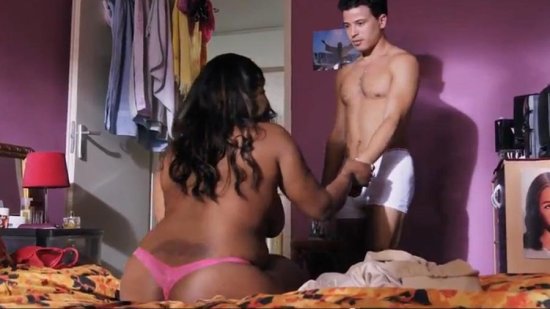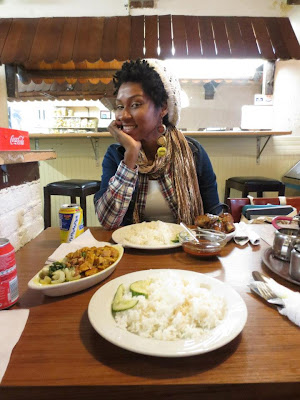Race, Degradation and Apathy in the Netherlands
by Shantrelle Lewis
Shuffering and Shimiling: Race, Degradation and Apathy in the Netherlands
 |
| Still from the film Alleen Maar Nette Mensen (Only Decent People). |
On December 19, 2011, Jackie, a popular Dutch lifestyle magazine ran a piece entitled “NiggaBitch.” It was then translated anonymously and sent to Parlour magazine, who uploaded the English-translated article in its entirety. In reaction, mass international outrage ensued. The article suggested that Dutch parents could opt to dress their daughters in the ghetto fabulous style of the so-called “ultimate niggabitch,” Rihanna, who reigned supreme with her “ghetto ass.” However, parents were warned that once dressed this in this manner, their little princesses turned niggabitches, would probably get into fights at daycare. [Yes, it’s ok. You have my permission to insert the appropriate WTF? here.]
Many people internationally, particularly in the U.S. wondered exactly how a magazine, especially one run by women, would have the audacity to publish such an offensive piece.
Was the Jackie office political correctness alarm broken that day? Most of us (decent people) were bewildered and straight flabbergasted. Verbal sentiment can’t accurately describe what many people experienced around the world upon reading the use of what writer Ayana Byrd referred to as “the vilest combination of words that you can call a black woman.” Then after Eva Hoeke, Jackie’s then Editor-In-Chief, was forced to resign, she went on to say that the whole situation was blown out of proportion, intended as a joke and also that it was a blessing in disguise.
This incident, which ended in Rihanna not so politely telling the editor how she felt about being called out her name, was appalling to many. It was also a wake up call of sorts or rather an introduction to the world of race and existence of racism in the Netherlands. Ironically, this incident occurred only a few weeks after the world was shocked by the footage of activist/artist Quinsy Gario, being dragged in the street and pepper-sprayed by police for wearing a shirt that said “Zwarte Piet is Racisme.”
Yes, good ole’ Zwarte Piet. Zwarte Piet “Black Pete” who is the ignorant, docile yet jolly servant of Sinterklaas, the Dutch-ified version of St. Nick, who goes around town on a horse accompanied by his “black” slave, I mean helper. The cherry on the top of this wonderful Dutch Christmas tradition, is that annually, during the last couple of months of the year, white people get to play dress up, as Black people. They blacken their faces in good-ole minstrel show fashion, with face paint called “negro.” They accessorize their newfound color with afro-wigs atop their heads, ruby red lipstick and gold hoop earrings. They then shuck and jive their way out of their homes to spread joy to all of the little good girls and boys who wait anxiously for their arrival and the treats that they bear. This is not some antiquated tradition that went out of style with minstrel shows and apartheid. This racist celebration still exists, today…as in 2012, as people gear up for this year’s Sinterklaas holiday celebrations.
For years, the Netherlands has been painted as a multi-cultural society where “tolerance” rules supreme. Let the Dutch tell it, there is no racism. Race and racism, according to the Dutch, are pre-occupations and problems of the U.S. and Americans, not Holland. Until recently, I barely knew that there existed a sizeable Black population in the Netherlands, thanks to the recent mass migration of Dutch Caribbean people, let alone a problem with race and racism.
Prior to me attending a screening of Alleen Maar Nette Mensen, which translates as Only Decent People, I had already been introduced to both the blatant and subtle white supremacist arrogance of the Dutch. However, nothing I had experienced via cinema or popular culture in my adult life, not even the worst of ignorant Black movies or 2Chainz videos could have adequately prepared me for the hour and half of pain I had to endure during the press screening of Only Decent People, a film based off of Robert Vuijsje’s best-selling book that actually went into dozens of editions of print prior to being made into a commercial film.
There are so many problematic issues with the production of Only Decent People, that it’s hard to condense them into a few statements. However, for the sake of clarity and contextualization, I will do my best to accurately describe the movie. To start, every single negative characterization of the Black woman as a hyper-sexualized being, loathed by all, even herself, was perpetuated. Scene after scene, all of the Black female characters were, for lack of a better word, beasts. They were all dehumanized creatures with the same exaggerated obese body type (with the exception of one who looked anorexic and was about to have a train run on her). They also performed, behaved and had sex while on their knees, sniffing people, growling and making animalistic noises. In other words, the Black women characters in Only Decent People were a present-day example of Saartjie Baartman redux.
Most Racist Offensive Scene Example#1: After the white Jewish lead character has found Rowana, his ghetto girl with her ghetto ass, he goes to her house the next day, where he is introduced to her brothers, two children and mother and then goes to the next room. They then start having sex wildly and loudly, meanwhile the family continues business as usual despite the amount of yelling that’s happening. I should probably add that before they engage in intercourse, Rowana sniffs him and growls like an animal while she’s crawling around on her knees. Oh, I should also mention that in this scene her breasts are flying everywhere including to the moon and back (because she’s mostly nude on camera) and she is “riding” him so hard that the bed starts to create holes in the floor.
Most Racist Offensive Scene Example #2: Perhaps the most dehumanizing scene of them all, entails the white Jewish character following his Black girlfriend’s cousin to an apartment complex in the Bijlmer (which in real life, is an apartment complex named Heesterveld that is the home of a community of young and emerging artists, many of whom are of African and Dutch Caribbean descent). For the sake of brevity I’ll skip the circumstances that led them there. What happened once they reached the apartment left my mouth agape. The woman, who never speaks, not a single line during the three to four scenes in which she is on screen, leads the two men into the basement of her apartment complex, with her small child still in his stroller. Once inside the storage room, she bends over, the Black man strips down her pants and penetrates her from the back. He then asks the white Jewish character, what he’s waiting for and hands him a condom. In the following scene, the woman is bent over as the Black man enters her from behind and she performs oral sex on the white guy, all while in the presence of her 3-year old son. Did I mention that this film is rated 12+ which means that children age 12 and older are allowed to watch the movie in its entirety in theaters?
Verder lezen: klik hier
 |
| Shantrelle P. Lewis |
Shantrelle Lewis (Caribbean Cultural Center, New York) werkt gedurende een aantal maanden in Nederland ter voorbereiding van een tentoonstelling over The Dutch Caribbean. Zij ontving de pestigieuze 2012 Curatorial Fellowship van de Andy Warhol Foundation. Lewis zal ook de voormalige Nederlandse Antillen en Suriname bezoeken.
In preparation for the fall 2015 exhibition Negotiating Identity: The Space Between Assimiliation and Resistance in Contemporary Dutch Caribbean Diasporan Art, curator Shantrelle Lewis will investigate the ways in which geopgraphy, language, cosmology, slavery, colonialism, independence and migration have shaped the identities (and the art practices) of artists in the Dutch caribbean diaspora, which encompasses Aruba, Curaçao, St. Maarten, Suriname and the Netherlands (including Bonaire, Saba and Sint Eustatius), perhaps due to a combination of language barriers and physical remoteness, there has been very little contemporary art scholarship that connects activitivity in the Dutch caribbean to larger conversations about the African diaspora in the Western hemisphere. Lewis will travel to the Netherlands for an extended stay during which she will make studio visits, identify artists for the exhibition and meet with art historians and scholars to identify essayistst and topics for the exhibition’s catalogue. The curator will travel to the Dutch Caribbean islands and Suriname to meet local artists, curators and scholars and to visit institutions such as Ready Tex Gallery (Suriname) and Institute Buena Vista (Curaçao). Lewis will document her meetings with videotaped interviews that will later be edited into a mini-documentary.
